37 Years with Roque Calvo
|
ECS Executive Director Roque Calvo has served as a steward of The Electrochemical Society for over 37 years, guiding the Society through tremendous changes while remaining dedicated to the Society’s mission to advance electrochemical and solid state science and technology. Now, as Calvo comes to the end of his tenure and begins transitioning out of his role at ECS, we are looking back at some of the Society’s greatest accomplishments during his time. Calvo joined ECS in 1980 as the accounting supervisor, managing the financial operations for the headquarters office. After two years, he was promoted to assistant executive secretary. In 1990, as then executive secretary V.H. (Bud) Branneky prepared for retirement, a search committee was established to find the individual who would fill that role and lead the Society into the future. |
“Roque just impressed us with his energy and ability,” said past ECS president Larry Faulkner, who was a member of the committee that would recommend the hiring of Calvo. “We had high confidence in him and I don’t think anyone who was involved in his hiring would have done it differently. Every one of us shared the view that it all turned out even better than we hoped.”
Calvo took the role of executive secretary in 1991, just the fourth person to hold that title in the Society’s then 88-year history. The title was changed to executive director in 1994.
“The Society was interested in self-renewal and I think we had the leadership and energy at that time with Roque inheriting the agenda,” Faulkner said. “Of course, he didn’t just inherit that agenda, he shaped it and turned it into something real.”
His position would prove over the next three decades to hold significant importance in guiding the Society through a technological shift, which changed the landscape for many nonprofit organizations.
Publishing paradigm
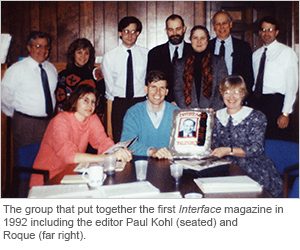 One of the first initiatives Calvo took on as the Society’s new leader was to establish ECS’s quarterly membership magazine, Interface. In a 1989 report, the ECS Long Range Planning Committee recommended creating a news-oriented publication to foster and implement ideas and achieve greater access for members to information on matters affecting the Society. Along with Paul Kohl, then a member of the ECS Publications Committee, and Barry Miller, who had recently become editor of the Journal of The Electrochemical Society, a team started meeting at ECS’s headquarters in Pennington, NJ, to brainstorm how to pull the magazine together. However, not all parties involved were on board, citing the potential for financial loss that could hurt the Society.
One of the first initiatives Calvo took on as the Society’s new leader was to establish ECS’s quarterly membership magazine, Interface. In a 1989 report, the ECS Long Range Planning Committee recommended creating a news-oriented publication to foster and implement ideas and achieve greater access for members to information on matters affecting the Society. Along with Paul Kohl, then a member of the ECS Publications Committee, and Barry Miller, who had recently become editor of the Journal of The Electrochemical Society, a team started meeting at ECS’s headquarters in Pennington, NJ, to brainstorm how to pull the magazine together. However, not all parties involved were on board, citing the potential for financial loss that could hurt the Society.
“Roque stepped forward and faced the financial consequences and he backed it,” said Kohl, who would serve as the first editor of Interface. “He was the right person at the right time to get it going and if he wasn’t there, it never would have happened.”
The ECS Board of Directors approved the new publication at the 1992 spring meeting, and the publication continues to see success to this day, having recently celebrated its 25th anniversary.
The next key initiative Calvo undertook in his new role was the digitization of ECS publications. As new technologies began to emerge and publishers started shifting their business model, Calvo led an aggressive effort to establish what would become the ECS Digital Library, using technology to advance the Society’s mission. A venture into unknown territory, much of this process was initially trial and error.
“Roque was bringing energy and vitality to the Society,” said Kohl, who served as editor of the Journal of The Electrochemical Society from 1995 to 2007, seeing the journal through its transition from an exclusively paper model to an online publication. “For so many people, if it’s not their concern and requires some work, they just pass the buck somewhere. But Roque would stand and try to address these issues.”
That positivity and forward thinking would help propel the Society into the digital age. Not only did Calvo undertake the immense project of overseeing electronic submission and the digitization of the publications, he also spearheaded the Society’s first website. In such a trying time with many unknowns and dozens of technological challenges, Calvo’s vision and hallmark positivity kept everyone engaged and focused on accomplishing the task at hand.
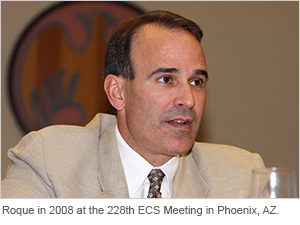 “Roque never said we couldn’t do something,” Kohl said. “It would always be, ‘Is there a way to do this? Let’s figure it out.’ That attitude was absolutely critical because every time we came to a stumbling block, Roque would find a new way to accomplish our goal.”
“Roque never said we couldn’t do something,” Kohl said. “It would always be, ‘Is there a way to do this? Let’s figure it out.’ That attitude was absolutely critical because every time we came to a stumbling block, Roque would find a new way to accomplish our goal.”
The ECS Digital Library was launched in 2006, and ECS chose the American Institute of Physics’ Scitation platform to be the host for its library. In addition to hosting all the newly published journal manuscripts, Calvo oversaw the effort to archive past papers, dating back to 1930. The continued expansion of the ECS Digital Library also led to the inclusion of ECS Transactions, which the Society began publishing in 2005 as a replacement for ECS Proceedings Volumes.
Through it all, Calvo’s business sense allowed him to control overall budgets and successfully navigate the publications into the digital world. The paradigm shift represented great opportunity for ECS, but as a small nonprofit publisher, the Society faced significant challenges, particularly in generating the necessary financial resources. Calvo’s ability to drive technological advancements and effectively manage the budget is one of the main reasons for the financial security and programmatic success that ECS is experiencing today.
In Calvo’s 26 years as executive director, net assets increased from $3.9M to $19.4M, a 6.36% CAGR.
International expansion
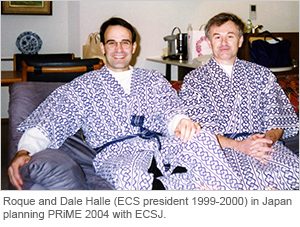 When ECS was founded in 1902, there were nine countries represented on the charter membership roster. As a result of Calvo’s guidance, the Society currently has members and involvement in more than 75 countries, having created a dynamic international community of electrochemists and solid state scientists and engineers.
When ECS was founded in 1902, there were nine countries represented on the charter membership roster. As a result of Calvo’s guidance, the Society currently has members and involvement in more than 75 countries, having created a dynamic international community of electrochemists and solid state scientists and engineers.
Before Calvo became executive director, ECS ran its first joint international meeting in Honolulu, HI, in 1987. As assistant executive secretary during that time, Calvo was able to gain hands-on experience and establish relationships with Japanese partners. Due to the increased interest and engagement at this meeting, Calvo knew it would be an enduring opportunity for the Society.
Upon gaining the executive director title, Calvo began to tackle new ventures in joint international meetings, overseeing strategy and relationship building with organizations around the world.
It wasn’t until 1993 when the chips fell into place again, marking the Society’s return to Hawaii for its second joint international meeting. Seeing the potential, Calvo began initiatives in branding this meeting, resulting in what we know today as PRiME. Global partnerships with The Electrochemical Society of Japan and later The Korean Electrochemical Society acted as the catalyst for the development of this highly successful meeting, with additional sponsorship from five other organizations from Australia, China, Korea, and Japan. PRiME has grown into the largest, most significant research conference in electrochemical and solid state science and technology.
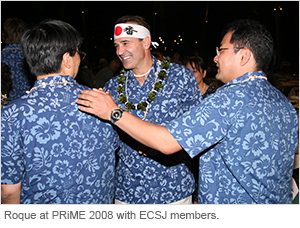 “PRiME helped to significantly raise the prominence of ECS,” said Fernando Garzon, ECS president during the PRiME 2012 meeting. “The meeting set a precedent that was then copied by other scientific societies. They saw the success of our meeting and that Hawaii was an excellent venue to bring together our Asian partners within the Society.”
“PRiME helped to significantly raise the prominence of ECS,” said Fernando Garzon, ECS president during the PRiME 2012 meeting. “The meeting set a precedent that was then copied by other scientific societies. They saw the success of our meeting and that Hawaii was an excellent venue to bring together our Asian partners within the Society.”
PRiME now occurs every four years in the very same venue in which the inaugural meeting took place, its level of attendance having grown from approximately 2,500 participants to now nearly 4,000 researchers from all corners of the world. The eighth PRiME meeting is scheduled for October 2020 and is expected to surpass existing benchmarks.
Calvo continued the joint meeting branding strategy through the creation of the Americas International Meeting on Electrochemical and Solid State Science, which this year will be held in October. This global partnership strategy was extended to the Sociedad Mexicana de Electroquímica in 2006 when the two organizations held the first of a continuing series of joint international meetings in Cancun, Mexico. After another successful joint meeting in 2014, the conference took on its own, unique identity. AiMES 2018 will include sponsorship from the Sociedade Brasileira de Eletroquímica e Eletroanalítica and the Sociedad Iberoamericana de Electroquímica, with high expectations of AiMES being the most important meeting in our field ever convened in the Americas.
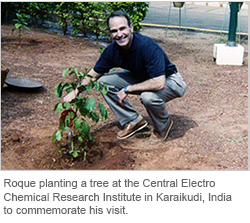 Under Calvo’s guidance, ECS has also held joint partnership meetings in China and Europe, and Calvo has established both sponsored and satellite meetings, opening the door to integrate such significant meetings as the International Meeting on Lithium Batteries, the International Symposium on Solid Oxide Fuel Cells, and the China Semiconductor Technology International Conference.
Under Calvo’s guidance, ECS has also held joint partnership meetings in China and Europe, and Calvo has established both sponsored and satellite meetings, opening the door to integrate such significant meetings as the International Meeting on Lithium Batteries, the International Symposium on Solid Oxide Fuel Cells, and the China Semiconductor Technology International Conference.
Through international partnership efforts, Calvo led ECS to continue fulfilling its mission by advancing the science on an international scale, building relationships with over a dozen professional societies, including the Chinese Electrochemical Society, the Society for Advancement of Electrochemical Science and Technology (India), the International Society of Electrochemistry, the International Conference on Solid State Ionics, the Institute of Electrical and Electronics Engineers, and others already mentioned in this article.
In 2017, 55% of meeting abstracts and 75% of journal manuscripts were from international authors.
Meetings, meetings, meetings
In addition to international expansion, Calvo piloted ECS to significant growth through the implementation of new programs at its biannual meetings. He guided the development of the Electrochemical Energy Summit, with the first summit taking place in 2011 during the 220th ECS Meeting in Boston, MA. Since the inaugural event, the energy summit has taken place every year during the fall biannual meeting, bringing together policy makers and researchers to discuss the critical issues of energy needs and the pivotal research in electrochemical energy. He also initiated the first Science for Solving Society’s Problems Challenge in 2014, which was created in partnership with the Bill & Melinda Gates Foundation and awarded a grand total of $360,000 in funding to innovative researchers working to address world sanitation issues.
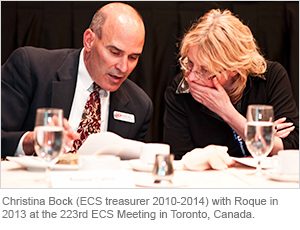 Calvo’s leadership has also significantly impacted symposia planning at ECS biannual meetings, leading to larger and more diverse meetings and a steady increase in attendance. In 1995, utilizing new technologies, ECS began accepting electronic abstract submissions, which has led to major improvements in program development. And in the same year, ECS introduced technical exhibits at biannual meetings, which have led to long-term success in providing a venue for exhibitors to interact with world-renowned researchers.
Calvo’s leadership has also significantly impacted symposia planning at ECS biannual meetings, leading to larger and more diverse meetings and a steady increase in attendance. In 1995, utilizing new technologies, ECS began accepting electronic abstract submissions, which has led to major improvements in program development. And in the same year, ECS introduced technical exhibits at biannual meetings, which have led to long-term success in providing a venue for exhibitors to interact with world-renowned researchers.
But technological shifts were not always easily embraced within the Society. From his oversight of the implementation of electronic abstract submission to the development of a comprehensive constituent database, Calvo consistently used his managerial and business sense to back decisions and deliver clear, concise communications on the importance of these moves to a diverse scientific community.
“Implementing these changes really took the skill of an international diplomat,” Garzon said. “We joke at the university that trying to organize scientists and engineers is like herding cats. Roque is very good at herding cats.”
His work with U.S. funding agencies also allowed the various ECS symposia to grow and expand, with Calvo communicating the importance of the work of the Society’s scientists to major institutions.
“Roque was very good at working with divisional leadership to make sure that the symposia we have in the Society reflect the national research interests,” Garzon said. “He made people understand that ECS was the place for their program managers to discuss the major research in areas like battery technology, fuel cells, and photovoltaics. And that is one of the greatest values that ECS provides its membership and meeting attendees, is that the Society has very high credibility with the folks who fund science.”
In 37 years, Calvo has championed the success of 75 consecutive ECS biannual meetings.
Student investment
Prior to Calvo’s tenure as executive director, the Society’s student activities relied heavily on university faculty networks to seed the new generation of scientists. Knowing that the Society’s future success depends on that, Calvo began investing in and expanding student programs.
One way student opportunities started to grow was through increased support and recognition of young researchers. Currently, ECS has 13 student awards, 9 of which were established during Calvo’s tenure, including the biannual meeting student poster session awards, which are among the now robust portfolio of student awards.
Shortly after Calvo became executive director, he and the ECS Education Committee realized that a poster session could function as an ideal platform for students to present their work, network with the top researchers in the field, and be recognized for their accomplishments. The first General Student Poster Session was held in 1993 at the 184th ECS Meeting in New Orleans with a successful first showing for the inaugural event, which featured a few dozen student posters. By now, this event has grown into an enormously effective program, highlighting young researchers from around the world, with 268 posters presented at the 232nd ECS Meeting in National Harbor in 2017.
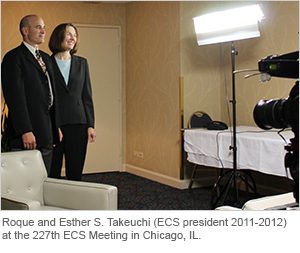 The objective was to enable an easier, more accessible opportunity for students to attend ECS meetings and create more interaction once they got there. Calvo directed the implementation of the ECS Student Mixer, creating a unique opportunity at the time for students to network with senior scientists and engineers, fellow students from around the world, and like-minded thinkers. And, working with the ECS divisions, he has enabled the awarding of around $75,000 in student travel grants annually to assist students with attending ECS biannual meetings.
The objective was to enable an easier, more accessible opportunity for students to attend ECS meetings and create more interaction once they got there. Calvo directed the implementation of the ECS Student Mixer, creating a unique opportunity at the time for students to network with senior scientists and engineers, fellow students from around the world, and like-minded thinkers. And, working with the ECS divisions, he has enabled the awarding of around $75,000 in student travel grants annually to assist students with attending ECS biannual meetings.
The development of ECS student chapters allowed for students to continue exploring new opportunities outside of meeting settings. Student chapters were established under Calvo’s leadership in the late ‘90s through the ECS Council of Sections. During that time, a group of students from Penn State came to the Society looking for official recognition from a professional society to gain full access to university resources as a student affiliation. Upon this request, Calvo and Daniel Schwartz, then chair of the Council of Sections, worked together to draft the guidelines for what would become ECS student chapters.
“The student chapters have become one of the more vibrant membership-oriented activities over the years,” Schwartz said. “Roque shepherded this program through leadership so that we were actually able to have the chapters. ECS is a good organization for students, and the chapters provided one more opportunity and kicked off a whole student program that would be built around this.”
The creation of student chapters allowed young researchers new opportunities to network with the Society’s constituents, gain funding to support chapter activities, get access to career resources, and partner with local sections. Student chapters have become wildly successful, with over 70 having been established around the world, providing students the opportunity to pursue new opportunities and ECS the ability to establish communication with this vital group of researchers.
In Calvo’s 26 years as executive director, student participation in ECS programs has more than doubled.
Membership and constituent programs
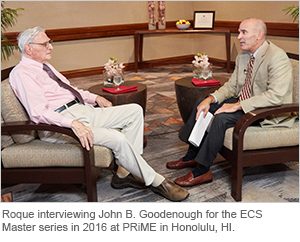 With Calvo’s tenure came a new, robust honors and awards program. Changes were implemented and new awards were established, leading to a total today of 53 Society, student, division, and section awards. The development of new awards allowed for researchers to be recognized for their accomplishments, giving those individuals stature in the field as well as the potential to get more funding for the programs due to this increased recognition.
With Calvo’s tenure came a new, robust honors and awards program. Changes were implemented and new awards were established, leading to a total today of 53 Society, student, division, and section awards. The development of new awards allowed for researchers to be recognized for their accomplishments, giving those individuals stature in the field as well as the potential to get more funding for the programs due to this increased recognition.
ECS’s membership now stands at over 8,000 constituents, with the Society consistently developing new opportunities for members to advance their professional careers and access innovative grant programs. These include several new summer fellowships and the addition of the ECS Toyota Young Investigator Fellowship in 2014, which provides yet another resource for early researchers to connect with a major industrial organization and receive funding to pursue innovative work.
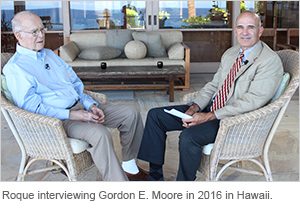 With committee and staff assistance, Calvo managed the creation of a professional development program in 1997. This program consists of workshops, professional panels, and career resources that help both early career researchers and experienced professionals learn integral information about the field and propel their careers in the right direction. These programs were added to the already established short courses to offer members opportunities to learn about some of the hottest topics in the field from academic and industry experts.
With committee and staff assistance, Calvo managed the creation of a professional development program in 1997. This program consists of workshops, professional panels, and career resources that help both early career researchers and experienced professionals learn integral information about the field and propel their careers in the right direction. These programs were added to the already established short courses to offer members opportunities to learn about some of the hottest topics in the field from academic and industry experts.
Finally, in 2014, Calvo started the process of expanding member recognition beyond the honors and awards program by establishing the Society’s first marketing department. Again, Calvo looked to harness new technological advances and promote the Society and its members by creating a digital media library with videos, podcast, and other new media initiatives.
In Calvo’s 26 years as executive director, 29 new awards were established.
Free the Science
Throughout his career with the Society, Calvo watched as the amount of research published grew exponentially. With the increased amount of content out there, accessibility started to become an even more important issue, especially in light of the rising subscription costs of large, for-profit publishers.
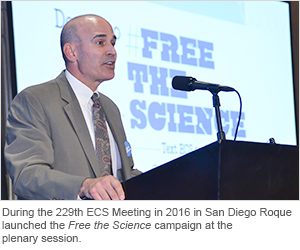 When Calvo started with the Society in 1980, the scholarly publishing model was vastly different, with only paper journals and subscription prices that were affordable to most universities and institutions. As for-profit publishers began dominating the scholarly publishing field and smaller, nonprofit publishers struggled to compete, the entire publishing model started on a drastic evolution, brining into question price barriers and access to information.
When Calvo started with the Society in 1980, the scholarly publishing model was vastly different, with only paper journals and subscription prices that were affordable to most universities and institutions. As for-profit publishers began dominating the scholarly publishing field and smaller, nonprofit publishers struggled to compete, the entire publishing model started on a drastic evolution, brining into question price barriers and access to information.
In a 2010 Interface article, “Chasing the Great White Whale,” Calvo described this issue and emphasized the need for the free, open dissemination of research. “ECS is the steward of electrochemical and solid state science and technology, which is an increasingly important role now that commercial enterprises dominate scientific publishing and stymie the advancement of our science,” he said in the article. “The reality in the new millennium is that scientific publishing can, but should not be, a money-making proposition.”
This new publishing reality had significant implications on the Society’s mission to disseminate research to advance the science, and this was not lost on Calvo, whose strategic compass was based on the mandate of the ECS mission. This threat compelled Calvo to study and diagnose the issues and changes in research publishing long before the Society’s initiative known as Free the Science would gain its name.
“High prices represent an obstacle in the dissemination of information and we cannot accept a situation where multibillion dollar corporations, who set high prices to generate large profits, determine what scientific research will cost and what results are publishable,” Calvo continued in the 2011 Interface article. “Our ultimate goal is to create open access to the ECS Digital Library, which means ECS is planning to eliminate the cost obstacles for the scientific research that we publish.”
The elimination of the price barrier would be Calvo’s great white whale, a reference to Herman Melville’s Moby Dick, a story about one captain’s passionate chase around the globe. Calvo continued pursuing this mission-based imperative, finally putting a name to the vision in 2013.
“Our goal is to provide open access to all the content in the ECS Digital Library and literally free the science for researchers in electrochemistry and solid state science all over the world,” Calvo said in a 2013 Interface article. “This is truly a risky walk across the high wire, but the possibilities of open access have made it an organizational imperative.”
That same year, he put together the Committee on Free Dissemination of Research, calling on Larry Faulkner to chair this committee made up of such prolific scientists as Allen Bard, Esther Takeuchi, Mark Wrighton, Tetsuya Osaka, and Martin Winter. The committee was charged with “evaluating the future of open access for ECS and its impact on scientific advancements in our field” and “making recommendations concerning ECS’s organizational structure, funding options, and advocacy requirements necessary for an open access model that will lead to successful and uninhibited scientific advancement.”
“Roque was central to our discussion and the work of that committee,” Faulkner said. “In fact, the Society’s ability to prepare for that committee and gather resources that could get us started toward making the changes we were discussing was heroic.”
In March 2014, the committee came to the conclusion that in addition to maintaining the high standards and rigorous peer review associated with ECS journals, the Society should pursue complete open access to keep the publications relevant and sustainable. The initiative kicked off by launching a hybrid open access program for ECS journals called Author Choice Open Access. To gain momentum, ECS began publishing open access manuscripts while providing a generous introductory waiver program for article processing charges.
The ECS Board of Directors approved the launch of the Free the Science campaign in 2015 with the long-term goal to help make the entire ECS Digital Library open access, eventually eliminating subscription costs while continuing to allow authors to publish their work for free.
“For me, this is the most important initiative in all my years of service and it is also the most daunting,” Calvo said during the plenary at the 229th ECS Meeting. “Undoubtedly, Free the Science is a bold vision and just as I have been supported by so many of you over the years, I ask for your support again now so we can advance this critical science at a pace I could never have imagined when this journey started.”
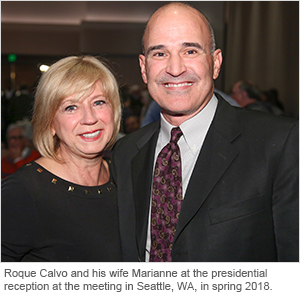 The Free the Science initiative has continued to expand over the past two years, incorporating ideas and values from the open science and open data movements. Through initiatives such as the launch of ECSarXiv, a preprint service developed through a partnership with the Center for Open Science, enhanced research dissemination with Research4Life, the Society’s first OpenCon event in 2017, and the start of the ECS Data Sciences Hack programming, ECS continues to move toward a future that embraces open science to further advance research in the fields of electrochemical and solid state science and technology.
The Free the Science initiative has continued to expand over the past two years, incorporating ideas and values from the open science and open data movements. Through initiatives such as the launch of ECSarXiv, a preprint service developed through a partnership with the Center for Open Science, enhanced research dissemination with Research4Life, the Society’s first OpenCon event in 2017, and the start of the ECS Data Sciences Hack programming, ECS continues to move toward a future that embraces open science to further advance research in the fields of electrochemical and solid state science and technology.
Since 2014, over 35% of the manuscripts published in ECS journals have been open access, and most importantly, ECS has experienced phenomenal progress in achieving the mission by increasing dissemination from the ECS Digital Library by 220% to over 3.5M downloads last year.
“If you are anywhere for over 37 years, like I have been at ECS things are going to happen,” said Calvo recently. “But to truly accomplish anything, it’s all about building relationships. As executive director, it has been my pleasure and honor to serve as the staff leader of a great international institution. Success in my position has required partnerships that have lasted for decades and generated ideas and support from volunteer leaders who serve on the board, committees, divisions, and as editors and symposium organizers. And, of course, the staff support has been essential. The many years of meetings and activities blend after a while, the journey is what I’ll remember and all the extraordinary people who have shared it with me.”
In 37 years, Calvo has served for 336 ECS board members while attending 89 consecutive board meetings.
Roque Calvo Next Generation Scholarship Fund
In honor of 37 years of service from Executive Director and CEO, Roque Calvo, The Electrochemical Society has created the Roque Calvo Next Generation Scholarship Fund.
Purpose: Ensure the participation of students and young investigators at ECS meetings through travel grants.
Goal: Raise $500,000 which will fund an additional 50 students per year to attend future ECS biannual meetings.
Donate: Learn more and make a donation here.
If you are interested in other ECS giving opportunities, please contact Development@electrochem.org.
